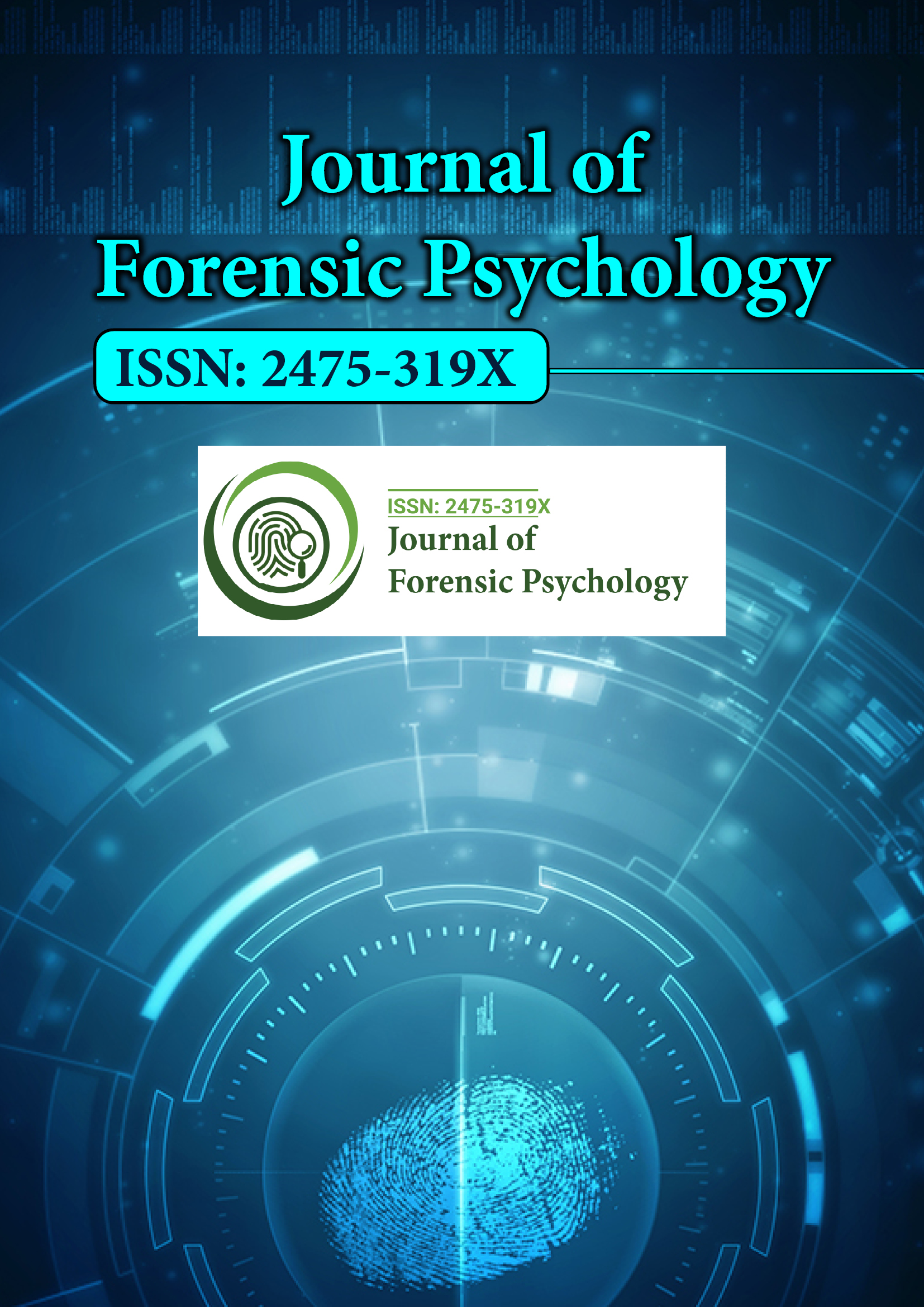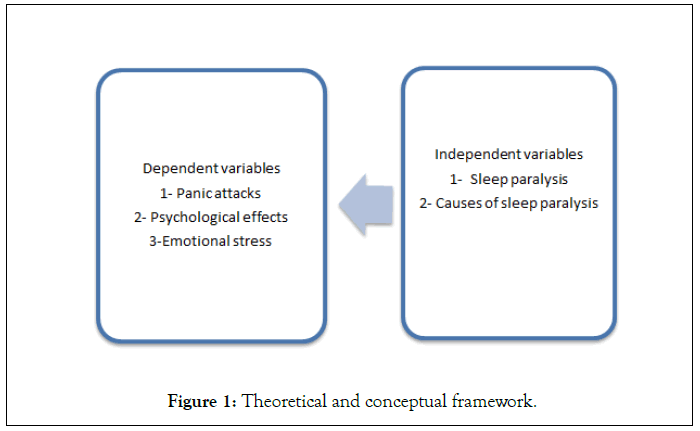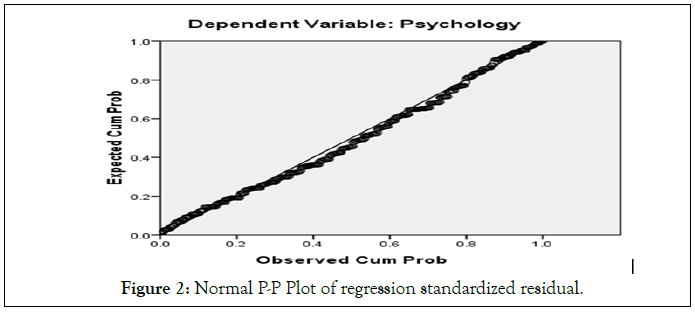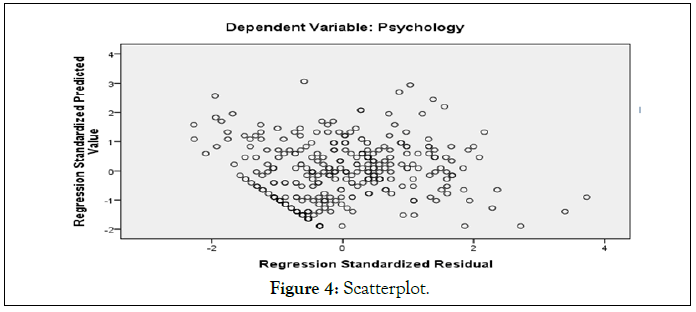Indexed In
- RefSeek
- Hamdard University
- EBSCO A-Z
- Publons
- Geneva Foundation for Medical Education and Research
- Euro Pub
- Google Scholar
Useful Links
Share This Page
Journal Flyer

Open Access Journals
- Agri and Aquaculture
- Biochemistry
- Bioinformatics & Systems Biology
- Business & Management
- Chemistry
- Clinical Sciences
- Engineering
- Food & Nutrition
- General Science
- Genetics & Molecular Biology
- Immunology & Microbiology
- Medical Sciences
- Neuroscience & Psychology
- Nursing & Health Care
- Pharmaceutical Sciences
Review Article - (2022) Volume 7, Issue 1
Effects of Sleep Paralysis on Human Psychology
Muhammad Sudais*, Ahmed Saddar and Maryam Ayesha KhalidReceived: 10-Jan-2022, Manuscript No. jfpy-22-15436; Editor assigned: 12-Jan-2022, Pre QC No. jfpy-22-15436; Reviewed: 25-Jan-2022, QC No. jfpy-22-15436; Revised: 31-Jan-2022, Manuscript No. jfpy-22-15436; Published: 07-Feb-2022, DOI: 10.35248/2475-319X.22.7.203
Abstract
Sleep paralysis is a state of consciousness experienced while waking from sleep or falling asleep. It is characterized by an experience of being unable to move for several seconds or minutes. Sleep paralysis entails a period of paralysis upon waking or falling asleep and is often accompanied by terrifying hallucinations. Many stressful environmental factors which cause emotional stress also induce sleep paralysis. In addition to stressful environmental factors being associated with the condition, there appears to be a dominant genetic factor associated with the predisposition for developing sleep paralysis. The implications of these findings for stress, anxiety, and sleep are discussed. Almost three hundred people from various age groups of Karachi city were targeted as the respondents. A multifactor questionnaire was constructed to measure the effects of sleep paralysis independent variable, and the human psychology dependent variable. Regression analysis was performed and proposed two models using SPSS. The results of statistical tests were concluded in a way that how sleep paralysis effects a person’s life. The final results showed the effects of sleep paralysis on one’s psychology and personal life.
Keywords
Sleep paralysis; Human psychology; Psychology; Regression
Introduction
Ever find yourself briefly paralyzed as you’re falling asleep or just waking up? It’s a phenomenon is called sleep paralysis, and it’s often accompanied by mysterious experiences, which can include unable to move, unable to speak, sensing presence of someone, frustration and intense fear. For some people, sleep paralysis maybe an once-in-a-lifetime experience; for others, it can be a frequent, even nightly, experience. This is a phenomenon which happens to almost everyone and most people who have suffered from this don’t know about it and how to deal with it. It seldom affects a person emotionally and mentally (Figure 1). Many people don’t believe in it and call it superstitious and fake. This research is important for awareness of this phenomenon and how to deal with it and help others. Our objective was to find out how sleep paralysis affects Human psychology so as to help people, who face sleep paralysis to control their fear of facing sleep paralysis (Table 1) [1].

Figure 1: Theoretical and conceptual framework.
| Model | R | R Square | Adjusted R square | Std. error of the estimate |
|---|---|---|---|---|
| 1 | .575a | .330 | .328 | .83791 |
Table 1: Model summaryb.
Literature Review
Most people considered this superstitious and fake. Hufford (March, 2005) has reported on the results of his work, which spans more than a decade. His original isolated sleep paralysis work began with a study of the college student population in Newfoundland. He surveyed 93 students and found that 23% had experienced sleep paralysis, known as the “Old Hag” in Newfoundland. Hufford’s research asserts that the phenomenon is found in a variety of cultural settings. Wilson (1925) first used what has become the most accepted term for this state of consciousness: sleep paralysis. He noted that it was a “transient physiologic disorder, a physiological cataplexy” (Figure 2).

Figure 2: Normal P-P Plot of regression standardized residual.
In Interpretation of Dreams2 Freud mentions hallucinations citing Johannes Muller’s (1826) term for this experience, “imaginative visual phenomena”. There is strong evidence that some claims of alien abduction may actually describe episodes of sleep paralysis. In a study by Spanos (1993) and a paper by Holden and French (2002) it is shown that 60% of intense UFO experiences are associated with sleep. In a study, French et al. (2008) found that people who claim to have been abducted by aliens report more incidences of sleep paralysis than a control group. Descriptions of alien abduction often bear strong resemblance to accounts of sleep paralysis [2].
A pilot study by Carl C. Bell, MD, Carolyn J. Hildreth, MD, Esther J. Jenkins, PhD, and Cynthia Carter (1988) which consists of 31 patients with elevated blood pressure revealed that 41.9 percent had isolated sleep paralysis, 35.5 percent had panic attacks, and 9.7 percent had panic disorder (Figure 3). These proposed hyper adrenergic phenomena may be related to the development of hypertension in certain individuals (Table 2). The study of Carl C. Bell, MD, Bambade Shakoor, MS, Belinda Thompson, PhD, Donald Dew, MSW, Eugene Hughley, MS, MSW, Raymond Mays, RN, and Kumea Shorter-Gooden (1984) represents the first survey to measure the incidence of this disorder in a black population of healthy subjects and psychiatric patients. In a study of J. A. CHEYNE (2004) the basic form and patterning of hallucinatory experiences is a result of intrinsic processes, independent of prior experience, likely associated with underlying REM neurophysiology [3].

Figure 3: Histogram.
| Model | Sum of squares | df | Mean square | F | Sig. |
|---|---|---|---|---|---|
| 1 Regression Residual Total |
101.166 205.012 306.178 |
1 292 293 |
101.166 .702 |
144.092 | .000a |
a. Predictors: (Constant), Sleep paralysis.
b. Dependent variable: Psychology.
Table 2: ANOVAb.
The study of Kazuhiko Fukuda, Robert D. Ogilvie and Tomoka Takeuchi (2000) stated that there were no differences between Canada and Japan in the prevalence and symptoms of Sleep Paralysis (SP), but many more Canadians considered SP to be a dream. The difference was considered to be derived from the fact that there is a common expression for SP in Japan but there is not one in Canada (Table 3). Then, we investigated why there are individuals who consider SP to be a dream and others who do not, and found that many Japanese who regarded it as a dream did not report the symptom of ‘unable to move’, while in Canada, self- evaluation of spirituality was different between the two groups [4].
| Model | Unstandardized coefficients | Standardized coefficients | ||||
|---|---|---|---|---|---|---|
| B | Std. Error | Beta | t | Sig. | ||
| 1 | (Constant) | .566 | .161 | 3.513 | .001 | |
| Sleep Paralysis | .729 | .061 | .575 | 12.004 | .000 | |
a. Dependent variable: Psychology.
Table 3: Coefficientsa
Hypothesis
Based on the stated theoretical and conceptual framework, following hypotheses are developed and tested in the research paper:
“Sleep paralysis has long-term effects on a person’s psychology, imposing negativity and anxiety in people which includes panic attacks and emotional stress”.
Methodology
We have collected our data by designing a kind of Questionnaire to measure our dependent variable (i.e., Human psychology) and independent variables (i.e., Sleep paralysis). We have divided a Questionnaire in 3 sections in which we have section A, B, and C for Demographic Information, Sleep Paralysis and Human psychology respectively. Section B and C contain 10 and 7 questions respectively with 5 point Likert scaling (Strongly Agree to Strongly Disagree). We filled out almost 300 questionnaires from various people from different age groups through visiting and circulating Google forms online (Figure 4). All subjects were fully informed as to the nature of the investigation and were assured that all data collected on them would be kept completely confidential. After analysis of Demographic Information, we found that we have collected our data from 34% females and 66% males in which mostly are young (i.e., 55% respondents are 16-20 years old) and people with moderate experience (i.e. 58% respondents have experienced it often). To analyze the data, we have used linear regression (simple and multiple). In statistics, linear regression is an approach for modeling the relationship between a scalar dependent variable y and one or more explanatory variables (or independent variables) denoted X (Table 4). The case of one explanatory variable is called simple linear regression. We have also used correlation and ANOVA (Analysis of Variance) between the variables. A correlation is a single number that describes the degree of relationship between two variables. ANOVA is a statistical analysis tool that separates the total variability found within a data set. The ANOVA test for regression is used to determine the impact independent variables have on the dependent variable in a regression analysis (Table 5) [5,6].

Figure 4: Scatterplot.
| Minimum | Maximum | Mean | Std. Deviation | N | |
|---|---|---|---|---|---|
| Predicted Value | 1.2944 | 4.2089 | 2.4077 | .58760 | 294 |
| Residual | -1.90601 | 3.12269 | .00000 | .83648 | |
| Std. Predicted Value | -1.895 | 3.065 | .000 | 1.000 | |
| Std. Residual | -2.275 | 3.727 | .000 | .998 |
a. Dependent variable: Psychology.
Table 4: Residuals statisticsa.
| N | Sleep paralysis | Psychology | |
|---|---|---|---|
| Sleep Paralysis | Pearson Correlation | 1 | .575** |
| Sig. (2-tailed) | .000 | ||
| N | 294 | 294 | |
| Psychology | Pearson Correlation | .575** | 1 |
| Sig. (2-tailed) | .000 | ||
| N | 294 | 294 |
Note: **. Correlation is significant at the 0.01 level (2-tailed).
Table 5: Correlations.
R-squared is a statistical measure of how close the data are to the fitted regression line. It is also known as the coefficient of determination. It is the percentage of the response variable variation that is explained by a linear model. R-squared is always between 0 and 100% where 0% indicates that the model explains none of the variability of the response data around its mean and 100% indicates that the model explains all the variability of the response data around its mean [7].
A major difference between R-squared and the adjusted R-squared is that R-squared supposes that every independent variable in the model explains the variation in the dependent variable. It gives the percentage of explained variation as if all independent variables in the model affect the dependent variable, whereas the adjusted R-squared gives the percentage of variation explained by only those independent variables that in reality affect the dependent variable.
The standard error of the estimate is a measure of the accuracy of predictions made with a regression line.
Σ (Y-Y’) 2
The sum of squares represents a measure of variation or deviation from the mean. It is calculated as a summation of the squares of the differences from the mean.
Unstandardized coefficients indicate the average change in independent variable associated with 1-unit change in the dependent variable standardized coefficient. In statistics, standardized coefficients or beta coefficients are the estimates resulting from a regression analysis that have been standardized so that the variances of dependent and independent variables are 1. Therefore, standardized coefficients refer to how many standard deviations a dependent variable will change, per standard deviation increase in the predictor variable [8,9].
Discussion and Conclusion
We can conclude from our study that Sleep paralysis has some effects on a person’s psychology, imposing negativity and anxiety in people. Sleep paralysis sometimes causes emotional stress and occurs mostly between 16-35 age groups.
Sleep paralysis is more common from 16-35 age groups. Almost 58% people have experienced it where they are unable to move and speak and are conscious of their surroundings. Almost 49% people experienced the feeling of a presence in the room with you and felt pressure on their body parts. Almost 40% people felt they might die while experiencing sleep paralysis. Many people who have not experienced it don’t believe others who have experienced it. Having less sleep and in emotional stress can also be a contributing factor for experiencing sleep paralysis because out of the people who have experienced it, 54% people slept less than 7 hours. 47% people experiencing it suffered emotionally and were frustrated and depressed after experiencing it. 34% people’s social life was affected after experiencing it and caused them troubles.
Sleep paralysis is relatively common in the general population and more frequent in students and psychiatric patients. Given these prevalence rates, sleep paralysis should be assessed more regularly and uniformly in order to determine its impact on individual functioning and better articulate its relation to psychiatric and other medical conditions. The most common causes for inducing sleep paralysis are lack of sleep, irregular sleeping schedule, sleeping in supine position (with face upwards), sudden stress, excessive use of medication and alcohol.
REFERENCES
- Jalal B, Simons-Rudolph J, Jalal B, Hinton DE. Explanations of sleep paralysis among Egyptian college students and the general population in Egypt and Denmark. Transcult Psychiatry. 2014;51(2):158-75.
- Sharpless BA, Barber JP. Lifetime prevalence rates of sleep paralysis: A systematic review. Sleep Med Rev. 2011 1;15(5):311-315.
- Bell CC, Hildreth CJ, Jenkins EJ, Carter C. The relationship of isolated sleep paralysis and panic disorder to hypertension. J Natl Med Assoc. 1988;80(3):289.
- Bell CC, Dixie-Bell DD, Thompson B. Further studies on the prevalence of isolated sleep paralysis in black subjects. J Natl Med Assoc. 1986;78(7):649.
- Cheyne JA. Sleep paralysis and the structure of waking-nightmare hallucinations. Dreaming. 2003;13(3):163-79.
- Szklo-Coxe Ma, Young T, Finn L, Mignot E. Depression: Relationships to sleep paralysis and other sleep disturbances in a community sample. J Sleep Res. 2007;16(3):297-312.
- Otto MW, Simon NM, Powers M, Hinton D, Zalta AK, Pollack MH. Rates of isolated sleep paralysis in outpatients with anxiety disorders. J Anxiety Disord. 2006;20(5):687-93.
- Takeuchi T, Fukuda K, Sasaki Y, Inugami M, Murphy TI. Factors related to the occurrence of isolated sleep paralysis elicited during a multi-phasic sleep-wake schedule. Sleep. 2002;25(1):89-96.
- Fukuda K, Ogilvie RD, Takeuchi T. Recognition of sleep paralysis among normal adults in Canada and in Japan. Psychiatry Clin Neurosci. 2000;54(3):292-3.
Citation: Sudais M, Saddar A, Khalid MA (2022) Effects of Sleep Paralysis on Human Psychology. J Foren Psy. 7:203.
Copyright: © Sudais M, et al. This is an open-access article distributed under the terms of the Creative Commons Attribution License, which permits unrestricted use, distribution, and reproduction in any medium, provided the original author and source are credited.

